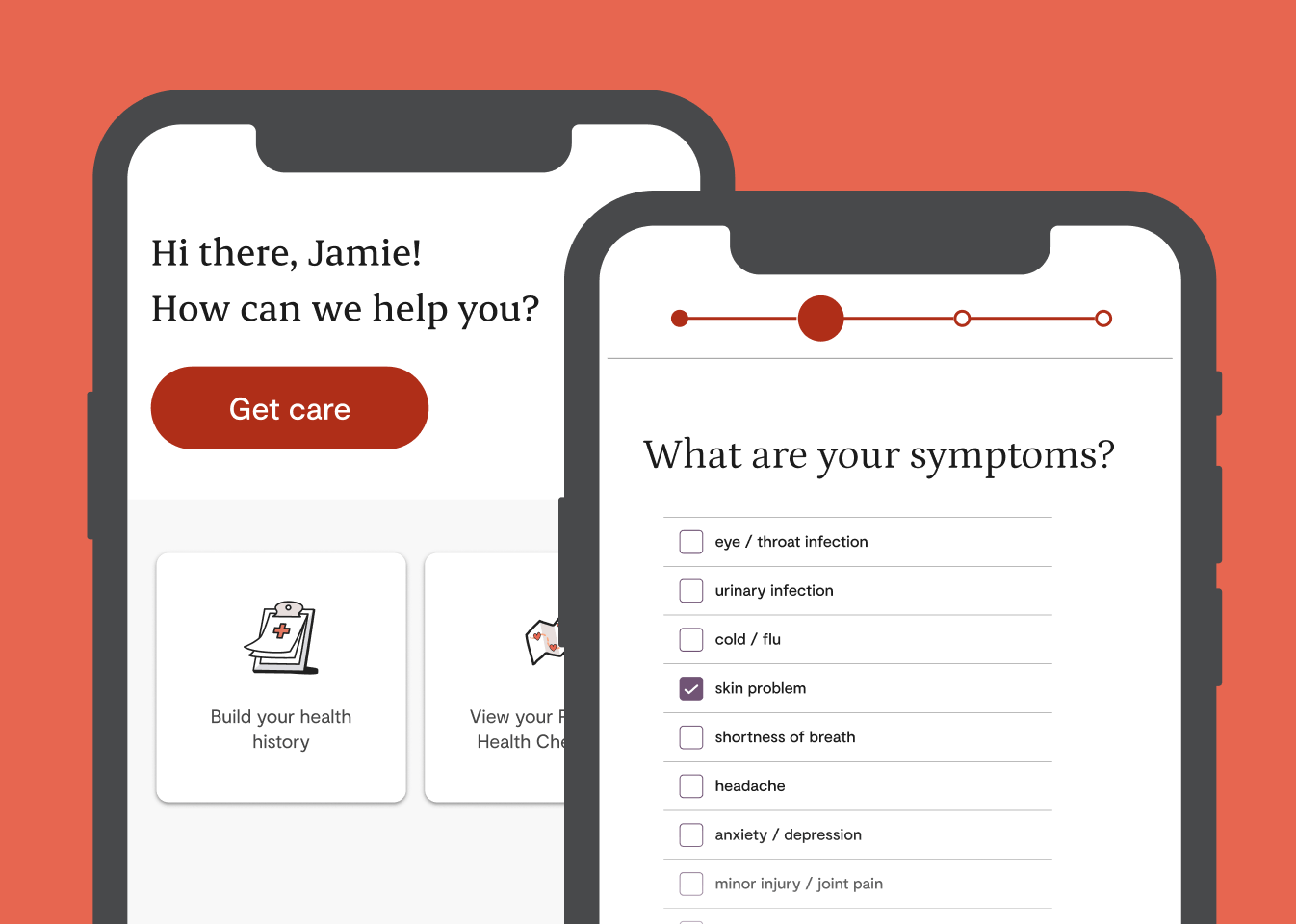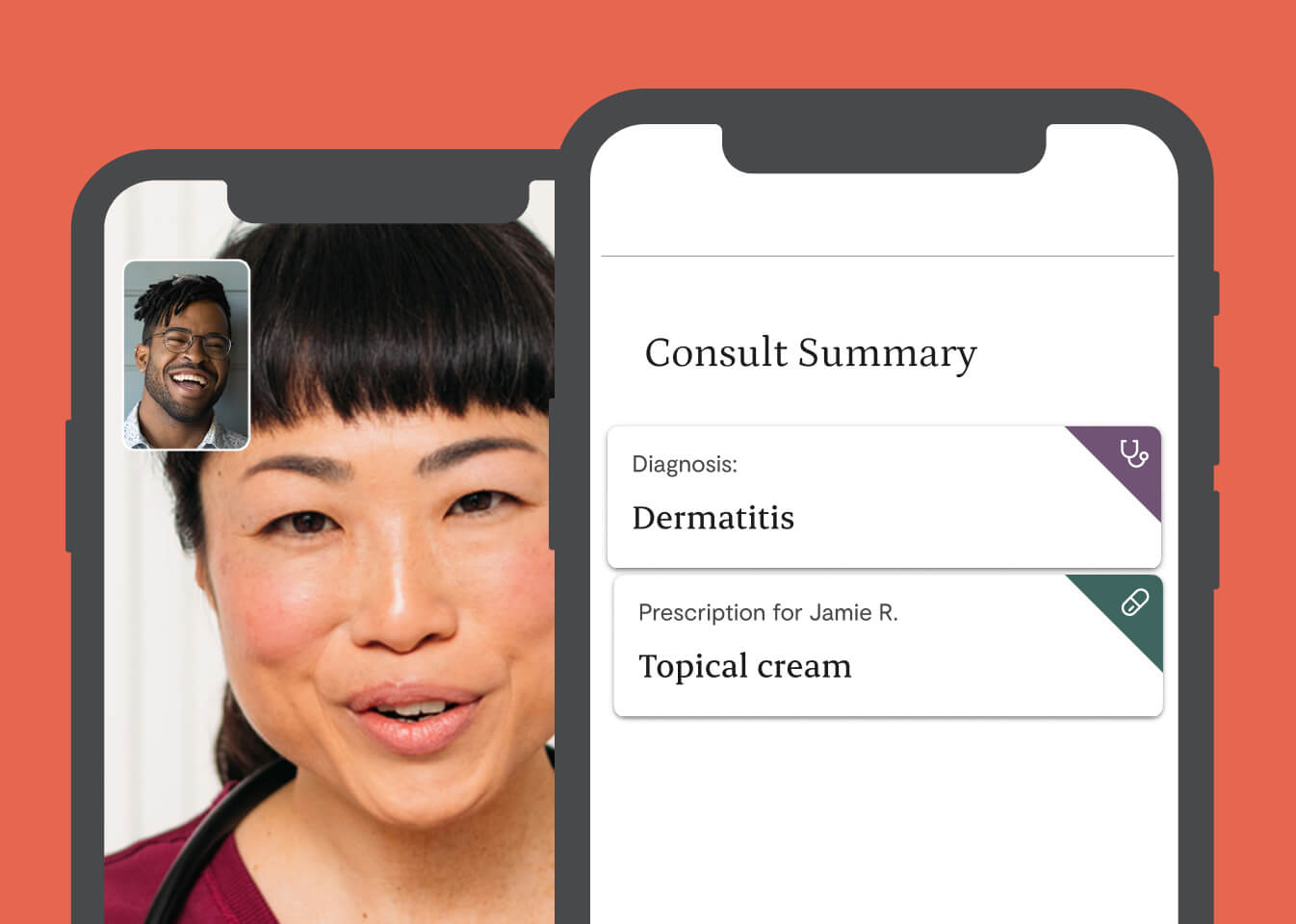Stasis dermatitis treatment, diagnosis & prescriptions
Skip the waiting room! Instantly connect with Canadian doctors for medical care from your phone, tablet or computer - any time, 24/7.

- Prescriptions available at a provider's discretion
- Speak to a doctor or nurse practitioner
- 24/7 availability
- Get connected in minutes
Trusted by millions of Canadians
- 4.8 rating30K+ App Store reviews
- 4.7 score8K+ Trustpilot reviews
Talk to a doctor about stasis dermatitis treatment online
See a doctor or nurse practitioner today to get a new prescription or refill, at their discretion.
See a provider in three easy steps.
- 1
Register and become a member

- 2
Select the “Get care” button on our homepage

- 3
Connect with a Canadian-licensed doctor or nurse practitioner in minutes

Why Canadians love Maple
A fantastic way to get medical advice when you are unable to see someone in person. The app is so simple to use. Highly recommend. I am not a tech savvy person but the doctor was kind enough to patiently walk me through every step of the process. Thank you.
Saved me hours waiting in the ER.
Fast and effective tool for getting a diagnosis and prescription.
The doctor willingly took the time to explain things to me.
Very easy to book a therapist and get appointment receipts.
Frequently asked questions
About Stasis Dermatitis
Yes, they can. The healthcare practitioner will want to discuss the symptoms and signs of stasis dermatitis that you’re experiencing, as well as examine the skin on your legs.
In some cases, the healthcare practitioner may suggest additional testing to check the blood flow in your legs.
Once the healthcare practitioner can provide a clear stasis dermatitis diagnosis, they’ll be able to suggest appropriate treatments for your stasis dermatitis.
Yes, our physicians can prescribe stasis dermatitis medications online during your consultation. Once you accept a prescription for stasis dermatitis, you’ll have the option to pick it up from any pharmacy or to have it delivered right to your door at no additional cost.
Stasis dermatitis, also known as gravitational dermatitis, venous eczema, and venous stasis dermatitis, is a form of dermatitis resulting from venous hypertension (poor blood flow). Due to the fact that poor blood flow usually affects the lower legs, symptoms and signs of stasis dermatitis appear most often near the ankles.
When blood pools in the veins of your lower legs, the pressure on these veins increases, which damages your capillaries. Eventually, this damage can allow proteins to leak into your tissues, which causes excess buildups of fluid, proteins, and blood cells.
In turn, this causes a swelling in the legs, known as peripheral edema. Experiencing this leaking is a condition called venous insufficiency. When people with venous insufficiency experience fluid pooling in their legs, it becomes stasis.
Symptoms and signs of stasis dermatitis most often appear on the lower legs and feet. They can appear on other areas of the body, but it’s much less commonly occurring.
The most commonly seen stasis dermatitis symptoms include:
- Swelling of the ankle or foot
- Orange-brown speckles of skin discoloration (sometimes called “cayenne pepper spots”)
- Changes in lighter skin tones (redness, brown, purple, gray, or ashen)
- Scaling
- Itching
- Dryness
- Achy or heavy feelings (especially after long periods of sitting or standing)
In some cases, stasis dermatitis can be identified with the associated symptoms of venous insufficiency, including:
- Leg swelling
- Calf pain or tenderness
The most direct cause of stasis dermatitis is poor circulation. Typically, this is the result of venous insufficiency, which is a chronic condition.
There are a number of other conditions that are known to also cause stasis dermatitis, or increase the risks of experiencing it, such as:
- Deep vein thrombosis (blood clots)
- Traumatic leg injuries
- Varicose veins
- Congestive heart failure
- Certain surgeries (e.g., bypass surgery removing a leg vein)
- Severe obesity
- Kidney failure
- Hypertension (high blood pressure)
- Pregnancy
- Not exercising
- Sitting or standing without moving for long periods of time
In order to provide a diagnosis for stasis dermatitis, a healthcare practitioner will want to evaluate the signs of stasis dermatitis you’re experiencing. This will involve examining the skin on your legs.
In some cases, the healthcare practitioner may suggest additional testing, such as a doppler ultrasound, to test the blood flow in your legs.
Once you have a clear diagnosis for stasis dermatitis, the healthcare practitioner will suggest treatments for stasis dermatitis based on its cause. This will include any prescription stasis dermatitis medications that may be required.
In many cases, stasis dermatitis treatments start at home. Making changes to your lifestyle can be very helpful for managing this condition. This includes:
- Elevating your feet when sitting
- Avoiding long periods of sitting or standing without movement
- Wearing loose-fitting clothes to minimize skin irritation
- Wearing compression stockings
- Exercising as recommended
- Walking briskly for 10 minutes after each hour of sitting
- Losing excess weight
When stasis dermatitis symptoms are severe, the doctor may suggest trying prescription stasis dermatitis medications like corticosteroid creams and ointments.
In cases where stasis dermatitis is caused by an underlying condition, treating the underlying condition will be part of the stasis dermatitis treatment plan.
If you’ve begun showing signs of stasis dermatitis, it’s a good idea to talk to a healthcare practitioner from Maple.
A healthcare provider can help provide a clear diagnosis for stasis dermatitis, and suggest stasis dermatitis treatments that will help you manage your symptoms.
Stasis dermatitis symptoms can be uncomfortable and embarrassing, but they won’t go away on their own. A healthcare provider from Maple can suggest lifestyle changes that will let you manage your symptoms. They can also provide prescription stasis dermatitis medications that are required as part of your treatment plan.
Maple 101
Maple is a virtual care platform that connects you with doctors and other healthcare providers via text, audio, or video. After you log in to your Maple account, you can request an online consultation.
Consultations work similarly to in-person appointments — the doctor can complete an assessment by asking questions about your symptoms, going through your health history, and determining what treatment is right for you. If they think your condition is more serious, they may tell you to go to a clinic for an in-person examination.
As a Maple member, you get 24/7 access to virtual primary care online and more. You can connect with our network of providers via text, audio, or video call within minutes.
Pricing and Payment
Our membership costs $85/month and covers virtual care for patients and their families, including the primary account holder's spouse and any dependents.
For patients in eligible provinces, our membership includes:
- Access to daily primary care provider visits: One daily visit with a primary care provider for each family member in their household.
- Paediatric care: Covered paediatric primary care visits, available by appointment.
- Second medical opinions: access to a network of experts for a second opinion if diagnosed with a complex condition (e.g. cancer).
- Personal Health Check-Ins: A series of personalized, evidence-based proactive care screenings to maintain and improve health.
- iCBT courses: Access to iCBT (internet-based cognitive behavioural therapy) self-assessment and courses.
- Access to specialists in eligible provinces: Easy access to specialists on Maple within days, not months. No referral is needed.
- Specialist referrals in eligible provinces: Ability to be referred to a physician specialist for in-person care, if needed.
- Credit discounts: An $80 credit per month to be applied to a Maple specialist visit.
Please note that our membership cannot be combined with other offerings, such as private insurance coverage and provincial programs, where available. In some cases, membership fees can be covered by a Healthcare Spending Account (HSA) — check with your HSA provider for more details.
We accept all major credit cards, including AMEX cards, as well as Google and Apple Pay.
Security and Privacy
At Maple, we proudly prioritize privacy as a cornerstone of our virtual care services. We strictly adhere to privacy and healthcare legislation in Canada, such as PIPEDA and PHIPA regulations, to ensure patients' personal and health information remains completely private and safeguarded.
Our policies and consent processes are designed to be simple and easily understood, empowering individuals with control and a clear understanding of their healthcare journey. When using our services, a patient’s session is protected by a comprehensive security infrastructure and stringent data policies.
Patients also retain full control of their personal health information, medical records and test results at all times. Our approach is reinforced by consultations with leading experts, guaranteeing comprehensive policy frameworks that are reviewed at a regular cadence.
All providers delivering healthcare through Maple are licensed in Canada and governed by their licensing regulatory colleges, and in all instances, must act in accordance with the governing principles set out in the telemedicine policies of each medical regulator in the applicable province.
Regulators across Canada support and recognize the value of services like ours, and the way in which they can benefit patients, physicians, and Canada’s broader healthcare system by improving access to care and increasing efficiencies in the delivery of care.
Do you need medical care today?
Trusted, experienced doctors and nurse practitioners are ready to see you.
Maple is safe and effective for common non-emergency issues. If you believe you are experiencing an emergency, please call 911 or proceed to your nearest emergency room.










